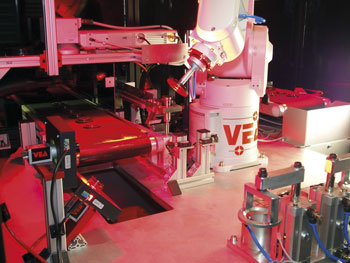Measuring during production as in the lab
A specialist in artificial vision systems, VEA proves that in the production environment measurements may be obtained which are qualitatively comparable to those of a metrological lab. All of this is made possible by new technologies
by Fabio Rosi
In many industrial sectors it is increasingly required that all products should correspond to specifications. Manual or semi-automatic systems have been around for some time which satisfy this requirement, but their properties are not always comparable to laboratory instruments; sometimes lab instruments are used in industrial environments and, not having been designed for this purpose, they tend to lose in repeatability and accuracy. The manufacturing sector demands more and more the automatic measurement of items with a frequency that often reaches and goes beyond thousands of items per hour; measurements may be associated to a qualitative control which may be cosmetic and/or functional. The requested accuracy is on the other hand aligned with that provided by lab instruments. This type of apparatus falls within the new funding envisaged by the national Industry 4.0 strategic plan.
Which are the risk factors in the production environments
In the production environment, unlike the metrological laboratory, there are some key aspects which affect the performances of measuring instruments. The main aspects which have proved most detrimental are: temperature range, vibration, dirt, lack of a specialized operator, speed of measurement. The solution lies in designing measurement instruments in a flexible and modular way and with a series of properties which take these factors into account. The robotised cell performs this function admirably as regards the automation of the grip, handing and release of the items. Special attention must be paid to measurement instruments placed inside the cell. Regarding the technical aspect, often a simple algorithm compensating for room temperature is not enough and a self-gauging three-stage system must be adopted, which factors in room temperature, the temperature of the item and the one of the gauge in self-gauging instruments. In an industrial environment the loss of accuracy in the instruments is on average higher than in the lab. For this reason the system must be self-gauging, that is, it must include reference gauges and an automatic procedure to verify any variation in accuracy. A great step forward in the increase of repeatability was the introduction of MSA (Micro Stabilized Accuracy) technology which allows to detect in real time the typical deviation of a predefined measurement, which enables to infer the repeatability of the instrument; in the case of an excessively high deviation, for instance, it may be decided to repeat the measurement, even because often enough vibrations are temporary phenomena.
Experience and artificial intelligence algorithms
No less important is the factor linked to cleanliness and to the lack of a specialized operator. Often it is overlooked that in production departments there is no laboratory staff, often there is no staff at all, nobody picks up the items, checks whether they are the right ones, cleans them places them carefully in the measurement machine, reads and evaluates results and records them correctly. All of this leads to designing machines with functions which verify the degree of cleanliness of the items and of the measurement supports, even using evolved algorithms which measure correctly analysing and filtering foreign components such as dust or oil. These plants have a vision system with a robot guide to pick up items arriving casually on the conveyor belt, which makes the machine much more flexible and at the same time it enables it to become aware of items not corresponding to production specifications; it my happen that on the production line items arrive by mistake which are of a different production lot with respect to the one which must be analysed, which could cause breakage of the gripping tool. These machines are designed to function 24 hours a day frequencies of thousands of items per hour. Such an amount of work implies the use of particular measurement instruments specifically designed for this purpose, completed by systems capable of verifying their reliability over time, if possible automatically. To conclude, it is definitely not easy to foresee everything which may happen in an industrial environment, but experience in the industry and the use of artificial intelligence algorithms helps us in this task.

